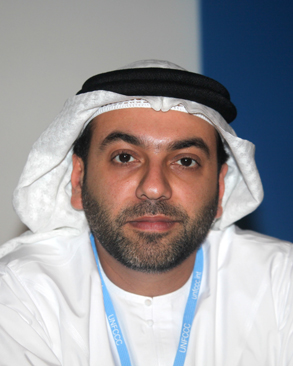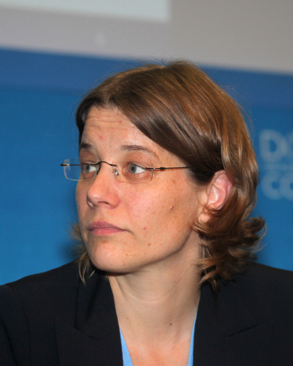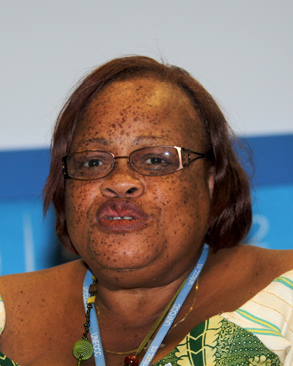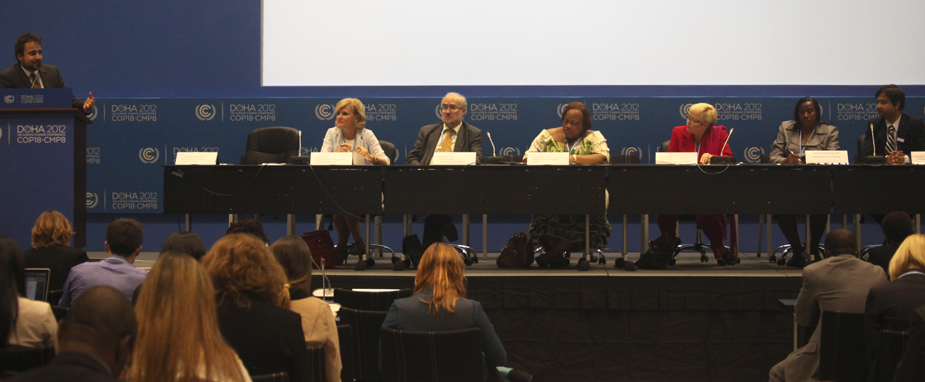|

 |
 |
 |
 |
REDD+ and Poverty Reduction:
What Has Worked and What Is Possible?
Presented by the International Centre for Integrated Mountain Development (ICIMOD),
Universidad Nacional Autónoma de México (UNAM) and University of Twente (UT)
|
|
 |
 |
 |
 |
Moderated by Michael McCall, UNAM, this event examined the role of REDD+ in poverty alleviation, exploring case studies from India, Nepal and Mexico. McCall noted the differences between poverty alleviation and poverty reduction, specifying that reduction is a general term, while alleviation targets a number of people and not the entire poor population.
Bhaskar Singh Karky, ICIMOD, presented a pilot project in Nepal on a REDD+ payment system for community forestry. He noted that the aims of the project are awareness raising, capacity building and carbon monitoring in the field. He stressed that linking community forestry and REDD+ offers an example of an effective, decentralized and sustainable system to respond to climate change, but requires reliable financing.
Tek Maraseni, University of Southern Queensland, presented a case study from Nepal concerning strengthening stakeholder governance of REDD+. He described the community-centered project, highlighting findings that show REDD+ policies are contributing to poverty alleviation through job creation and community participation.
Vijay Rawat, Indian Council of Forestry Research and Education, presented a national-level approach to REDD+, highlighting his country’s experience. He noted that although India began to implement REDD+ very recently, the government already has a climate change policy and strong forestry management policies and programmes. He noted that the government is implementing REDD+ in the Indian Himalayas.
Stressing that the REDD+ discussion has been focused mainly on rainforests, Margaret Skutsch, UT/UNAM, called for a greater focus on degraded tropical dry forests, which support large populations. She noted that REDD+ payments in these areas could be used to reduce forest degradation and enhance forest stocks. Arturo Balderas, UT/UNAM, made a technical presentation on designing local forest carbon programmes as a mechanism to reduce poverty. He explained that the organization made use of the livelihoods approach.
Resham Dangi, REDD Forestry and Climate Change Cell, Nepal, noted that, much as they have the capacity to aid in poverty alleviation, forests themselves need to be protected. He called for exploring simple solutions that link conservation, government practices, and poverty alleviation and reduction at the local level. He noted simple language is needed to communicate with communities, and stressed that safeguards are “not a negative concept.”
In the discussion, participants considered: the enabling conditions to implement REDD+ in non-rainforest areas; the role of government in community-led projects; how to equally distribute REDD+ payments to all user groups, including women; the misconceptions about shifting cultivation; and the role of the media in disseminating information on REDD+ activities. |
Moderator Fahad Al-Sherehy, SABIC Research and Technology (R&T), introduced the panel, which focused on Saudi Aramco’s Flaring Mitigation Program and highlighted environmental regulations in Saudi Arabia’s industrial cities and its development of clean transport fuels.
Walid Al-Naeem, Saudi Aramco, highlighted Saudi Aramco’s Flaring Mitigation Program, which includes the development of a real-time flare monitoring system (FMS) to provide base data that can be used to develop annual Flaring Minimization Plans (FMPs), saying the goal is to mitigate flaring to less than 1% of total sales gas production.
Esam Al-Sayid, Saudi Aramco, discussed zero discharge technology. He said flares are used to eliminate waste gas and as a safety measure to release high pressure, but noted they have environmental and health impacts and said they waste valuable resources. He emphasized that, historically, all gas was flared, but now it is only used during emergencies and for “pilot plus purge.” He highlighted benefits of zero flaring as: enhancing Saudi Arabia as steward of environment; reducing air pollution; and qualifying Saudi Arabia for emissions reductions credits.
Mohammad Al-Haji, Saudi Aramco, outlined the development of Saudi Arabia’s Master Gas System (MGS) to efficiently use flared gas. He described the gas processing scheme used on gas associated with oil recovery, noting that gas is used by desalination plants, the power generation sector and other industrial plants. He said the MGS will continue to be enhanced to responsibly mitigate environmental impacts while efficiently meeting energy demand.
Abdullah Alshaalan, Royal Commission for Jubail and Yanbu (RCJY), Saudi Arabia, highlighted environmental management in two industrial cities, Jubail and Yanbu. He noted a number of regulations for: controlling dust emissions; controlling wastewater treatment emissions; testing stacks to check compliance; utilizing best available techniques; monitoring continuously; testing for fugitive emissions; and phasing out ozone-depleting substances.
Saeed Al-Alloush, Saudi Aramco, discussed the Fuel Quality Roadmap (FQR) in Saudi Arabia designed to reduce pollutants emitted from vehicle transport. He said its objectives include: improving environmental quality; improving human health; achieving excellence in product specifications; maintaining a competitive position in global exports; and ensuring compatibility with future automotive technologies. He highlighted reducing sulfur, benzene and aromatics control, and limiting volatility as ways to produce cleaner fuels. He highlighted efforts to retrofit refineries to produce cleaner fuels, including at the Rastanura and Riyadh refineries.
Al-Sherehy emphasized Saudi Arabia’s commitment to addressing environmental issues. During discussions, participants considered: technical aspects of the Flaring Mitigation Program; sulfur emissions from diesel; supply chains for transportation fuels; and environmental benchmarking by the RCJY. |
 |
 |
 |
 |
CCS: Opportunities in the GCC Region
Presented by Qatar and ClimateNet
|
|
 |
 |
 |
 |
This panel, moderated by Björn Dransfeld, ClimateNet, addressed carbon capture and storage (CCS) opportunities in the GCC region, with panelists presenting regional experiences and discussing opportunities to harness climate finance and policy to support CCS.
Saif Saed Al-Naimi, Qatar Petroleum, presented on the relevance of CCS activities in the GCC region, with a focus on Qatar. He highlighted the potential of CCS to contribute to global emissions reductions, and, noting that CCS involves capture, transport and storage components, said total CCS cost estimates range from US$40-100 per tonne of CO2. He shared Qatar’s experiences with CCS technologies, including a joint project between Shell, Qatar Petroleum, Qatar Science and Technology Park and Imperial College London. He suggested several international laws and frameworks that could provide guidance on CCS regulations for transboundary projects, including treaties and conventions on liability, transboundary waste and transboundary waters.
Ali Al-Meshari, Saudi Aramco, outlined the potential for enhanced oil recovery (EOR) projects in the Middle East, outlining the challenges and enablers of EOR development. Detailing the percent of oil recovered in each of the three stages of oil recovery, he said the first stage recovers less than 30% while EOR allows between 50-80%. Among the challenges to EOR, he listed the price of oil, high capital investments needed and the long lead-time required for projects.
Axel Michaelowa, Perspectives Climate Change (Perspectives), discussed opportunities for harnessing carbon markets to finance CCS, noting that more opportunities might be available under nationally appropriate mitigation actions and the New Market Mechanism than under the Clean Development Mechanism (CDM). He highlighted several factors that must be addressed for CCS projects to be considered in carbon markets, including: the risk of seepage, where carbon sequestration might not be stable; challenges with project boundary issues, such as reservoirs in international waters; allocating long-term liability for storage sites; and setting criteria and steps for the selection of suitable storage sites.
Arafat Al Yafei, Abu Dhabi National Oil Company (ADNOC), shared experiences from his country and company on carbon capture utilization and sequestration (CCUS), and outlined ADNOC’s work on CO2 injection. He outlined the research and development process for screening reservoirs and developing EOR and CCS pilot projects, noting ADNOC’s focus on EOR for commercial reasons, but interest in CCUS development for a longer-term focus on mitigation. Listing the key elements needed for CCUS projects, he emphasized the role of leadership, vision and political commitment.
In discussions, participants addressed: the business incentives for EOR and CCS, separate from climate benefits or policies; the Arab world’s commitment to emissions reductions and global environmental stewardship; and opportunities for carbon markets in the GCC region. |
 |
 |
 |
 |
High Level Event on Technology Transfer and Finance
Presented by the Global Environmental Facility (GEF) and Asian Development Bank (ADB) |
|
 |
 |
 |
 |
This event, moderated by Robert Dixon, GEF, Andrew Steer, World Resources Institute (WRI), and Ajay Mathur, Director, Green Climate Fund (GCF), included two panels addressing technology transfer and financing, which considered financing, networks, the role of multilateral development banks and private sector investment.
Naoko Ishii, CEO, GEF, noted the history of GEF involvement in technology transfer, stressing the Poznan Strategic Programme on Technology Transfer to mobilize investment in environmentally-sound technology and management practices in developing countries. She underscored the need for continued partnership and financial support, and added that the GEF should act as an innovator, with technology transfer remaining a key activity.
Bindhu Lohani, ADB, highlighted that addressing climate change in Asia is about access to technology. Lohani stated that growth projections and infrastructure investments could provide a new opportunity for low-carbon development, however noted additional resources are required. He highlighted a new partnership between ADB, GEF and the UN Environment Programme to facilitate technology transfer and bring technologies to market.
During the first panel, Steer highlighted four keywords for discussion: technology; finance; networks; and centers. Xuedu Lu, ADB, called for establishing a pilot low-carbon technology marketplace and facilitating access to finance for climate technology investments. Encouraging investment in Africa, Mafalda Duarte, African Development Bank (AfDB), highlighted that technology transfer is needed to multiply productivity and close the technology literacy gap between countries.
Claudio Alatorre, Inter-American Development Bank, focused on working with existing regional institutions, noting that in addition to renewable energy, energy efficiency and transport, they need to focus on forestry monitoring. Craig Davies, European Bank for Reconstruction and Development, stressed using finance to overcome barriers and “de-risk” the adoption of new technologies, noting private sector investment.
During the second panel Mathur questioned how to move money from old to new technologies and what role the public sector should play to encourage private sector investment. Ryutaro Yatsu, Vice Minister of Environment, Japan, noted several programmes to encourage private sector investment, including a joint-crediting mechanism for private-sector investments to support green growth in developing countries.
Ekaterina Kushnereva, Cherbrooke, Russian Federation, noted the need for cooperation between public and private sectors, along with the role of education and training and new ecological business models. Roger Ammoun, Credit Suisse, emphasized that the public sector needs to “push” private capital into markets, anchored by regulation, as investors balance risks versus returns.
In conclusion, Mary Barton-Dock, World Bank, joined Ishii in discussing a vision for technology transfer and innovation. Barton-Dock noted the importance of: scaling up markets and existing technologies; increasing support at the policy level; partnering with regional development banks; and increasing international cooperation in research and development. On scaling up and replicating technology transfer, Ishii stressed the importance of “internalizing the climate externality,” calling for an enabling policy environment in which to do this. |
 |
 |
 |
 |
Energy Sustainability in GCC Countries
Presented by Gulf Cooperation Council (GCC)
|
|
 |
 |
 |
 |
|
 |
 |
 |
 |
 |
| Mohamed Al Midfaei, Integrated Environment Policy and Planning Agency, United Arab Emirates, stressed the need to decouple emissions from GDP growth, noting that Abu Dhabi is lagging behind its developed world counterparts in this respect. |
|
 |
 |
 |
 |
|
|
Moderated by Mohammad Al-Hajri, Saudi Aramco, this event explored various sustainability-enhancing initiatives in the GCC, focusing on industrial sectors.
Al-Hajri presented Saudi Aramco’s water conservation strategy, highlighting that freshwater consumption is to be cut by 70% and water-use cut by 36% by introducing water efficiency technologies. He spoke about projects identified to achieve the company’s targets, stressing his company’s commitment to share their experience with others in the region.
Announcing that SABIC is a partner in the UN Global Compact, Ken Miller, SABIC, presented the sustainable journey of SABIC. He noted that in order to achieve sustainability, important elements to be considered include social responsibility, eco-efficiency, transparency, providing space for innovation and creating innovative leadership in the industry. He also spoke on the company’s efforts to reduce their carbon footprint.
Gretchen Govoni, SABIC R&T, presented the application of a life-cycle approach to sustainability, recognizing climate concerns. Highlighting that her organization is a carbon-based company, she noted the specific carbon emissions from the transportation of raw materials, manufacturing processes, consumer-use phase of products and end-of-life phase. She said that SABIC focuses on reducing GHG emissions, sustainable energy production, fresh water usage, and preventing and/or limiting material losses.
Lauding the trendsetting sustainability features of Yanbu Industrial City, Ayman Al-Mohammadi, RCJY, noted that this industrial city emerged from a transformation of fishing villages, and was chosen for its geographical location and proximity to oil. He highlighted that the city seeks to draw residents through its sustainable infrastructure, including houses, roads, pipelines and waste facilities.
Hussein Al-Beshrey, RCJY, spoke on the city of Jubail’s reuse of reclaimed water for energy savings and CO2 emissions reductions. Introducing participants to the city, he noted it plans to expand. On the RCJY’s regulatory work in the city, he stressed a ban on direct wastewater discharge into the Gulf. He also pointed to the city’s reuse of almost 100% of its daily industrial water capacity of 168,500 cubic meters.
Mohamed Al Midfaei, Integrated Environment Policy and Planning Agency, United Arab Emirates, presented on the experience of GCC countries in energy sustainability in the industrial sector, focusing on the activities of the Emirate of Abu Dhabi. He drew participants’ attention to the Abu Dhabi Environment Vision 2030, which seeks to chart the region towards a low-carbon economy, setting guidelines for adopting innovative green solutions for power generation and limiting waste generated from industries.
In the discussion, participants considered the regulation and streamlining of energy and water policies. |
 |
 |
 |
 |
NAMAs: Assessing Impacts, Technology and
Country Differences, Identifying Priorities
Presented by the Energy Research Centre of the Netherlands and
the Swiss Federal Institute of Technology Zurich (ETH Zurich)
|
|
 |
 |
 |
 |
|
 |
 |
 |
 |
 |
| Martina Jung, Ecofys Germany, listed benefits and drawbacks of RBF, noting it allows differentiated MRV and greater predictability of support, but involves ex-post financing and baseline uncertainties. |
|
 |
 |
 |
 |
|
|
Moderator Xander van Tilburg, ECN, introduced the session, which considered the development and financing of nationally appropriate mitigation actions (NAMAs). He explained the session would consist of a keynote address followed by three panels, on the appropriateness of NAMAs in the context of development, finance strategies and specific experiences with NAMA financing.
In his keynote address, Norbert Gorißen, Federal Ministry for the Environment, Nature Conservation and Nuclear Safety (BMU), Germany, outlined three sets of BMU-supported activities: broad projects on national concepts and low-carbon development strategies; the design and development of ambitious NAMAs; and the development of measurement, reporting and verification (MRV).
In the first panel, on NAMA appropriateness, Lachlan Cameron, ECN, presented a visualization tool to assist the assessment and communication of development impacts of mitigation actions, explaining this would help ensure NAMAs align with development priorities. Joern Huenteler, ETH Zurich, presented a matrix for assessing the design and production complexity of energy technologies.
In the second panel, on financing, Laura Würtenberger, ECN, presented the Mitigation Momentum project, aimed at supporting NAMA development. She discussed strategies for choosing financial instruments for NAMAs, suggesting funding proposals be developed in cooperation with donors and financing options be chosen based on local circumstances.
Pointing to the role of risk in increasing the cost of clean energy investments in developing countries, Tobias Schmidt, ETH Zurich, presented de-risking instruments to complement NAMA policies. He presented a tool developed by the UN Development Programme (UNDP), noting de-risking instruments could reduce financing costs by covering losses or remove financial barriers by eliminating the root causes of risk.
Martina Jung, Ecofys Germany, discussed results-based finance (RBF) for NAMA implementation, noting the concept links finance to verified achievements and can be applied in various ways. She suggested its application has the potential to combine the beneficial elements of carbon finance and carbon markets.
Syamsidar Thamrin, Indonesian Climate Change Trust Fund (ICCTF), introduced the Fund and reflected on how ICCTF delivers climate financing in Indonesia. She outlined ICCTF pilot projects, and highlighted its three focal areas for projects: land-based; energy; and adaptation.
Addressing the question of what lessons can be learned for NAMAs from the CDM experience, Renat Heuberger, CEO, South Pole Carbon, underscored there is no silver bullet in climate change mitigation action. He outlined some lessons learned from the CDM, including its success in finding least-cost abatement options and harnessing private finance.
During discussions, participants and panelists discussed, among other things: the UNDP de-risking tool; possibilities for legal frameworks for NAMAs; how NAMAs are addressed in national budgets; financing options from the GCF; training activities undertaken by the ICCTF; and the tools and incentives needed for transfers of complex technologies. |
 |
 |
 |
 |
Building Sustainable Health Systems: Focus on Climate Resilience
Presented by the World Health Organization (WHO) and Norway
|
|
 |
 |
 |
 |
|
 |
 |
 |
 |
 |
| Julia Duncan-Cassell, Minister of Gender and Development, Liberia, addressed key issues linking health and climate change, including: agriculture and food security; coastal area impacts; forests; flooding events; water and sanitation; and energy security. |
|
 |
 |
 |
 |
|
|
This session moderated by Maria Neira, WHO, addressed the relationships between climate and health. Neira emphasized health must be part of the climate agenda, discussing inter alia: climate-sensitive health risks; policies to improve health equity and address climate change; and improved health as a way to strengthen resilience. She highlighted increased donor engagement, technical support, and regional and national initiatives, but stressed these must all be continued.
Arvinn Eikeland Gadgil, State Secretary for International Development, Norway, highlighted the “Atlas of Health and Climate” jointly published by the World Meteorological Organization (WMO) and WHO. He identified three challenges: increasing unpredictability requires planning under conditions of uncertainty; combining health into the adaptation agenda requires mainstreaming into policy; and increasing extreme weather events require health ministries to engage in long-term planning for resilience.
Julia Duncan-Cassell, Minister of Gender and Development, Liberia, emphasized how climate change impacts the health of women, young girls and the elderly. She called for further collaboration between the UNFCCC and WHO to raise awareness, support country-level activities, and address climate and health in planning.
Michel Jarraud, Secretary General, WMO, stressed that the partnership between WMO and WHO helps the international community better understand climate-related health challenges, noting the Atlas is designed to demonstrate the benefits of cooperation between health and climate services. He underscored that more can be done through strengthened cooperation, such as through the Global Framework for Climate Services (GFCS).
Aaira Kalela, Global Campaign for Climate Action (GCCA) – Women’s Environment and Development Organization (WEDO), emphasized that 70% of the poor in many countries are women, and they should be further involved in planning climate and health policies, particularly agriculture and water. She stressed women are both victims and powerful actors in addressing climate and health.
Iqbal Kabir, Ministry of Health, Bangladesh, highlighted mainstreaming of health and climate into Bangladesh’s planning processes. He said the most vulnerable to climate change are also the poorest, noting the central role of health in poverty alleviation and increasing climate resilience.
Julian Kyomuhangi, Ministry of Health, Uganda, highlighted strong collaboration among different ministries, notably the agricultural, water and health ministries. She urged advocacy and awareness-raising activities to increase resilience through early warnings and risk reduction, and putting health at the heart of climate change.
During discussions, participants considered issues such as: actions by the South African Ministry of Health, which engaged stakeholders including civil society; specific health impacts of climate change in Burkina Faso, as well as policy responses; the “Doha Declaration on Climate, Health and Wellbeing” issued by an alliance of health and medical civil society organizations; and the effectiveness of bottom-up community health initiatives. |
 |
 |
 |
 |
 |
Panel (L-R): Arvinn Eikeland Gadgil, State Secretary for International Development, Norway; Maria Neira, WHO; Michel Jarraud, Secretary General, WMO; Julia Duncan-Cassell, Minister of Gender and Development, Liberia; Aaira Kalela, GCCA-WEDO; Julian Kyomuhangi, Ministry of Health, Uganda; and Iqbal Kabir, Ministry of Health, Bangladesh.
|
|
 |
 |
 |
 |
 |
The Earth Negotiations Bulletin on the side (ENBOTS) © <enb@iisd.org> is a special publication of the International Institute for Sustainable Development (IISD) in cooperation with the State of Qatar. This issue has been written by Tallash Kantai, Kate Neville, Anna Schulz and Anju Sharma. The Digital Editor is Kate Harris. The Editor is Liz Willetts <liz@iisd.org>. The Director of IISD Reporting Services is Langston James “Kimo” Goree VI <kimo@iisd.org>. Support for the publication of ENBOTS at the Doha Climate Change Conference - November 2012 has been provided by the State of Qatar. The opinions expressed in ENBOTS are those of the authors and do not necessarily reflect the views of IISD and funders. Excerpts from ENBOTS may be used in non-commercial publications only with appropriate academic citation. For permission to use this material in commercial publications, contact the Director of IISD Reporting Services at <kimo@iisd.org>. Electronic versions of issues of ENBOTS from the Doha Climate Change Conference - November 2012 can be found on the Linkages website at http://enb.iisd.org/climate/cop18/enbots/. The ENBOTS Team at the Doha Climate Change Conference - November 2012 can be contacted by e-mail at <anna@iisd.org>.
|
|
|